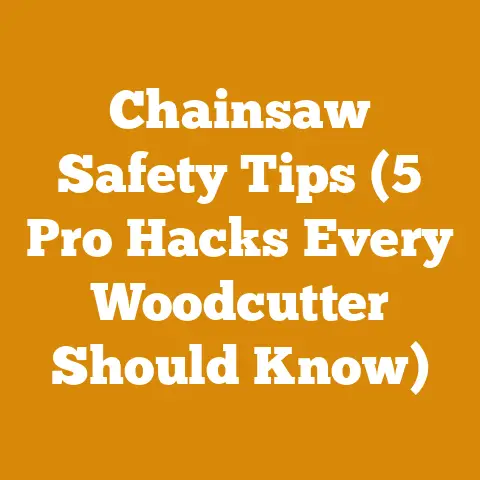3200 McCulloch Chainsaw Tips (7 Essential Maintenance Hacks)
Alright, buckle up, buttercups! Ever tried starting a 3200 McCulloch chainsaw that’s been sitting longer than your last relationship? It’s an experience, isn’t it? More frustrating than assembling IKEA furniture with missing instructions. But fear not! As someone who’s practically been baptized in bar oil and smells perpetually of sawdust, I’m here to give you the lowdown on keeping your 3200 McCulloch chainsaw purring like a kitten… a very loud, wood-chewing kitten. This guide will equip you with essential maintenance hacks to keep your trusty tool running smoothly for years to come.
3200 McCulloch Chainsaw Tips: 7 Essential Maintenance Hacks
The McCulloch 3200 is a workhorse, a classic. I remember my grandpappy swearing by his. But like any good tool, it needs a little TLC. Ignoring these essential maintenance hacks is like ignoring that nagging cough – it’ll turn into something far worse (and more expensive) down the line.
1. Fuel System Finesse: Keeping the Gas Flowing
A clogged fuel system is the bane of any chainsaw owner’s existence. Think of it like this: your chainsaw’s engine is a thirsty beast, and the fuel system is its straw. If that straw is blocked, the beast ain’t gonna drink (or cut).
- The Fuel Filter Fiasco: I change my fuel filter on my McCulloch 3200 every three months, or after every 50 hours of use. This little guy prevents debris from entering the carburetor. A clogged filter restricts fuel flow, leading to hard starting, poor performance, and even engine damage. I use a small hook tool to pull the fuel line out of the tank and then carefully remove the filter. Always replace it with a new, high-quality filter designed for your 3200 McCulloch chainsaw.
- Carburetor Conundrums: The carburetor mixes fuel and air for combustion. Over time, it can become gummed up with old fuel residue. I recommend using a carburetor cleaner spray at least once a year, or more frequently if you notice starting problems or rough idling. To properly clean the carburetor, you’ll need to disassemble it carefully, following the instructions in your owner’s manual. Pay close attention to the jets and passages, making sure they are clear of any obstructions. A tiny piece of wire or a carburetor cleaning tool can be helpful.
- Fuel Line Foibles: Fuel lines can crack and deteriorate over time, leading to fuel leaks and air leaks. Inspect your fuel lines regularly for cracks, kinks, or signs of wear. If you find any damage, replace the fuel lines immediately. Use fuel lines specifically designed for small engines, as they are resistant to the corrosive effects of gasoline. I typically replace my fuel lines every two years, regardless of their apparent condition. Prevention is key!
- Fuel Cap Follies: A faulty fuel cap can prevent proper venting, leading to a vacuum in the fuel tank. This can cause fuel starvation and poor engine performance. Make sure your fuel cap is in good condition and that the vent is clear. I often test the vent by blowing gently into the cap – you should feel air passing through.
Takeaway: A clean and properly functioning fuel system is crucial for reliable starting and optimal performance. Regular maintenance will save you headaches (and money) in the long run.
2. Spark Plug Savvy: Igniting the Fire Within
The spark plug is the heart of your chainsaw’s ignition system. It creates the spark that ignites the fuel-air mixture, powering the engine. A fouled or worn spark plug can cause hard starting, misfires, and poor performance.
- Spark Plug Inspection: I inspect my spark plug every month. Look for signs of wear, such as a rounded electrode, carbon buildup, or cracked porcelain. A healthy spark plug should have a clean, dry electrode with a sharp edge.
- Spark Plug Cleaning: If your spark plug is simply fouled with carbon, you can try cleaning it with a wire brush or spark plug cleaner. However, if the electrode is worn or the porcelain is cracked, it’s time for a replacement.
- Spark Plug Gap: The spark plug gap is the distance between the electrode and the ground electrode. This gap is critical for proper ignition. Refer to your owner’s manual for the correct spark plug gap specification for your 3200 McCulloch chainsaw. I use a spark plug gapping tool to ensure the gap is precisely set. Typically, the gap is around 0.025 inches (0.635 mm).
- Spark Plug Replacement: I replace my spark plug every year, regardless of its apparent condition. It’s a cheap and easy way to ensure reliable starting and optimal performance. Always use the correct type of spark plug for your chainsaw, as specified in your owner’s manual.
Takeaway: A healthy spark plug is essential for reliable starting and optimal performance. Regular inspection, cleaning, and replacement will keep your chainsaw firing on all cylinders.
3. Air Filter Acumen: Breathing Easy for Peak Performance
Your chainsaw’s air filter protects the engine from dirt, dust, and debris. A clogged air filter restricts airflow, leading to reduced power, poor fuel economy, and engine damage.
- Air Filter Inspection: I inspect my air filter after every use. If it’s dirty, I clean it immediately. A dirty air filter can significantly reduce engine performance.
- Air Filter Cleaning: Most air filters can be cleaned with warm soapy water. Gently wash the filter, rinsing it thoroughly. Allow the filter to air dry completely before reinstalling it. For heavily soiled filters, you can use a specialized air filter cleaner.
- Air Filter Replacement: I replace my air filter every six months, or more frequently if I’m working in dusty conditions. A clean air filter is crucial for optimal engine performance and longevity.
- Air Filter Type: My McCulloch 3200 uses a foam air filter. These are generally reusable after cleaning. Some newer chainsaws use paper or felt filters, which are typically disposable. Always use the correct type of air filter for your chainsaw.
Takeaway: A clean air filter is essential for optimal engine performance and longevity. Regular cleaning and replacement will keep your chainsaw breathing easy.
4. Chain Champions: Sharpening and Lubrication Mastery
The chain is the business end of your chainsaw. A dull chain is not only inefficient, but also dangerous. It requires more effort to cut through wood, increasing the risk of kickback. Proper chain lubrication is also essential for smooth cutting and long chain life.
- Chain Sharpening: I sharpen my chain every time I refuel. A sharp chain cuts smoothly and efficiently. I use a chainsaw file and guide to maintain the correct cutting angle and depth. There are also electric chainsaw sharpeners available, which can be faster and easier to use. I prefer to sharpen my chain by hand, as it gives me more control and allows me to tailor the sharpness to the type of wood I’m cutting.
- Filing Angle: The correct filing angle for your chain is typically printed on the chain itself or in your owner’s manual. For most chains, the top plate angle is around 30 degrees, and the side plate angle is around 60 degrees.
- Depth Gauge: The depth gauge controls the amount of wood each cutter takes. If the depth gauges are too high, the chain will not cut effectively. I use a depth gauge tool to file them down to the correct height.
- Chain Lubrication: I check my chain oil level before every use. A properly lubricated chain will cut smoothly and last longer. I use a high-quality bar and chain oil specifically designed for chainsaws. I adjust the oiler on my McCulloch 3200 to ensure that the chain is adequately lubricated. You should see a light spray of oil coming off the chain while it’s running.
- Oil Type: I use a biodegradable bar and chain oil whenever possible. This is better for the environment and helps to reduce the risk of soil contamination.
- Oiler Adjustment: The oiler adjustment screw is typically located on the bottom of the chainsaw, near the bar. Turning the screw clockwise increases the oil flow, while turning it counterclockwise decreases the oil flow.
- Chain Tension: I check my chain tension before every use and adjust it as needed. A properly tensioned chain should fit snugly on the bar but should still be able to be pulled around the bar by hand. Too tight, and it will bind and wear prematurely. Too loose, and it can derail.
- Tension Adjustment: The chain tension is adjusted by loosening the bar nuts and turning the tensioning screw. Turning the screw clockwise tightens the chain, while turning it counterclockwise loosens the chain.
Takeaway: A sharp and properly lubricated chain is essential for safe and efficient cutting. Regular sharpening, lubrication, and tension adjustment will keep your chainsaw performing at its best.
5. Bar Basics: Groove Cleaning and Maintenance
The bar guides the chain and supports it during cutting. A dirty or damaged bar can cause chain binding, premature wear, and even chain derailment.
- Bar Groove Cleaning: I clean the bar groove after every use. Use a bar groove cleaner or a small screwdriver to remove any sawdust, debris, or accumulated bar oil. A clean groove allows the chain to run smoothly and prevents binding.
- Bar Rail Inspection: I inspect the bar rails for wear or damage. The rails should be smooth and even. If they are worn or damaged, the bar may need to be replaced.
- Bar Flipping: I flip the bar over periodically to distribute wear evenly. This will extend the life of the bar. I typically flip the bar every time I sharpen the chain.
- Bar Oiling Hole: I make sure the bar oiling hole is clear. This hole allows oil to flow from the oiler to the bar and chain. A clogged hole can lead to chain starvation and premature wear.
Takeaway: A clean and well-maintained bar is essential for smooth cutting and long chain life. Regular cleaning, inspection, and flipping will keep your bar in top condition.
6. Storage Strategies: Protecting Your Investment
Proper storage is crucial for preventing damage and extending the life of your chainsaw. I’ve seen too many chainsaws ruined by improper storage.
- Fuel Drainage: I drain the fuel tank before storing my chainsaw for extended periods. Old fuel can gum up the carburetor and cause starting problems. I run the chainsaw until it stalls to ensure that all the fuel is used up.
- Chain and Bar Protection: I remove the chain and bar and clean them thoroughly. I then apply a light coat of oil to prevent rust. I store the chain and bar in a safe place, away from moisture and dust.
- Spark Plug Removal: I remove the spark plug and pour a small amount of engine oil into the cylinder. I then pull the starter cord a few times to distribute the oil. This will help to prevent rust and corrosion inside the engine.
- Storage Location: I store my chainsaw in a dry, well-ventilated location. Avoid storing it in direct sunlight or in damp conditions. A garage, shed, or workshop is ideal.
Takeaway: Proper storage is essential for preventing damage and extending the life of your chainsaw. Taking a few simple steps before storing your chainsaw can save you a lot of headaches (and money) in the long run.
7. Periodic Professional Check-ups: When to Call in the Experts
While I can handle most routine maintenance tasks myself, there are times when it’s best to call in a professional. Think of it like this: you can change your own oil, but you probably wouldn’t try to rebuild your engine without specialized tools and knowledge.
- Engine Overhaul: If your chainsaw is experiencing significant engine problems, such as loss of compression, excessive smoke, or unusual noises, it may be time for an engine overhaul. This is a complex repair that should be performed by a qualified technician.
- Carburetor Rebuild: If cleaning the carburetor doesn’t solve your starting or performance problems, it may need to be rebuilt. This involves disassembling the carburetor, replacing worn parts, and reassembling it to factory specifications.
- Safety Inspection: I recommend having your chainsaw inspected by a qualified technician at least once a year. They can identify potential problems before they become serious and ensure that your chainsaw is operating safely.
Takeaway: Don’t be afraid to call in the experts when needed. A professional technician can diagnose and repair complex problems and ensure that your chainsaw is operating safely and efficiently.
By following these 7 essential maintenance hacks, you can keep your 3200 McCulloch chainsaw running smoothly for years to come. Remember, a little preventative maintenance goes a long way. Now go forth and conquer those logs! And always, always wear your safety gear. You only get one set of eyes and ten fingers, so treat them with respect. Happy sawing!






